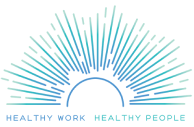The Healthy Work Campaign recently posted a series of Healthy Work Strategies case studies by our research associate Paul Landsbergis and graduate student researchers at SUNY Downstate, about the various efforts groups have made to reduce the significant stress related to working during the COVID-19 pandemic. Not only are there multiple groups concerned with decreasing exposure to the virus and protecting the health and safety of workers in general, but efforts have also been made to decrease stress.
The pandemic has caused much uncertainty, anxiety, and stress, touching nearly every aspect of our lives. About half of Americans report that the pandemic has negatively affected their mental health, with a large increase in reported emotional distress as well as increases in opioid deaths. Stressors can include increased unemployment and underemployment, increased workloads, reduced social support, difficulty attending to personal and family needs, and a blurring of the lines between work and home life.
Addressing the significant work stress related to the pandemic is also about addressing the inequities in COVID-19 outcomes that have been documented to be much worse among essential workers, workers of color, low income workers and immigrants. Stressful, low-income working and living conditions increase the risk of comorbid conditions, such as cardiovascular disease, hypertension and diabetes, as well as impaired immune function, all of which increase the likelihood of severe illness if a person is exposed to SARS-CoV-2.
In the series of Healthy Work Strategies case studies just posted, we give examples of various methods that have been implemented to help protect the health and safety of workers, including collective bargaining, laws and regulations, workers compensation, the development of guidelines for safe return to work, and mutual aid networks.
Examples:
Collective Bargaining: Members of United Teachers Los Angeles (UTLA) used their Contract Action Teams (CAT) to advocate for teachers being expected to do the administration’s work in addition to their regular teaching duties during the pandemic.
Laws & regulations: Despite various worker advocacy groups calling upon OSHA to pass an “emergency temporary standard (ETS)” to reduce worker exposure to SARS-CoV-2, there are still no OSHA standards directly responsible for protecting workers from airborne or aerosol transmission of diseases transmitted by airborne droplets. However, various states have taken the initiative to protect workers through executive orders or their own state OSHA ETS, including Virginia, Michigan, California, and New Jersey.
Workers Compensation: As of December 9, 2020, 17 states and Puerto Rico had extended workers’ compensation coverage of COVID-19 as a work-related illness for various workers. Despite these laws and orders that provide greater access to workers’ compensation for COVID-19, many workers are still having claims either held up or denied.
Community organizations are advocating for their members and working to establish guidelines for a safe re-opening of workplaces, to protect both consumers and workers. For example, the California Healthy Nail Salon Alliance has released guidelines that will help protect nail salon workers and customers from COVID-19 once they open. Some guidelines include limiting the number of people in the salon and number of services offered (workload and exposure to the virus).

Who We Are


What We Do

Healthy Work Assessments
For individuals and organizations
Solutions for Employers
Map your plan or book a consultation
Resources for Workers & Unions
Access free resources or schedule a workshop

Why We Do It

What is healthy work?
Learn what it is and what is not
Stats and Infographics
How work stress can harm your health
Business Case
The cost of work stress & why healthy work matters
Educational Media
Videos, interviews and presentations

Ways To Support

Join the Movement
Subscribe to our newsletter
Employer Matching
Build our capacity
Donate
Power our mission
Partner Giving
Extend our reach


≡